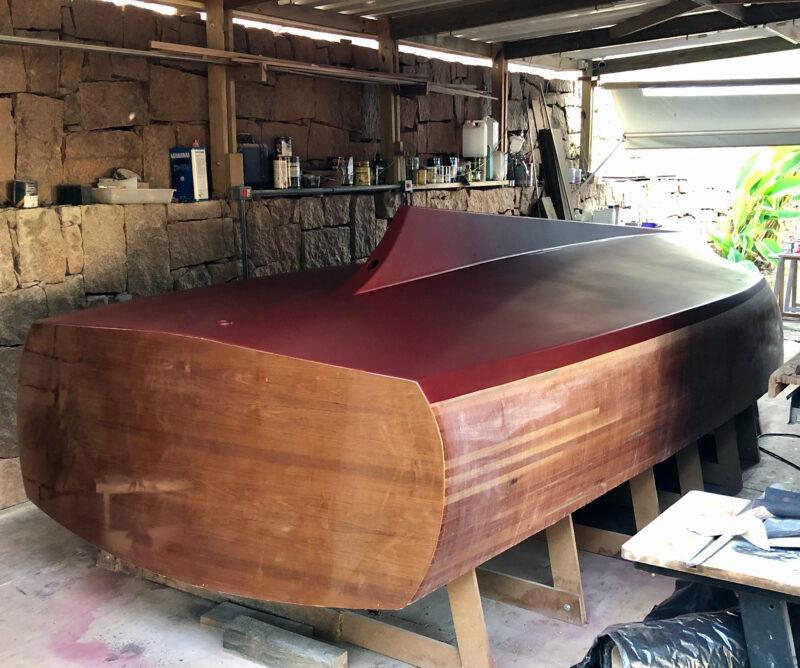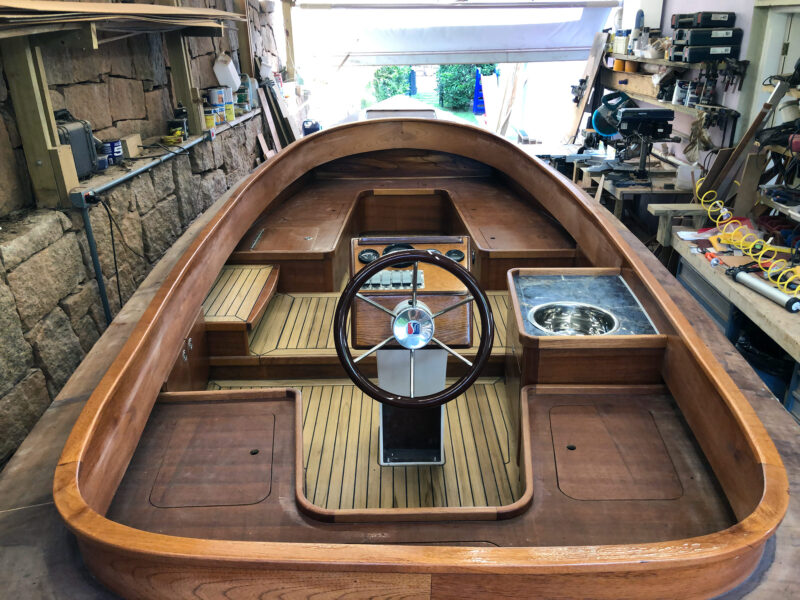Oliver Ilg’s journey to wooden boat building has been neither straight nor obvious. Leaving university in Brazil with a degree in physics (which he later augmented with an MBA), he was hired as a product engineer for a German car manufacturer. Four years later, he moved to another German car company in Brazil where he worked first as assistant to the general manager, and later as director of sales and marketing for the firm’s luxury cars. In his late 20s he was involved in building a 53′ steel yacht for his father, but it was not until his 40s that he left cars behind and became fully immersed in a nautical world.
In 2003, Oliver founded Sterling Yachts, building “modern classic fast trawler cruisers for the U.S. market.” The company adopted automotive-manufacturing techniques, outsourcing components and bringing them together in a proprietary assembly line. Within five years, says Oliver, Sterling Yachts had shifted its geographical focus and become a top player in the local market, introducing innovative craft like the Sterling Legend 28, the first Brazilian diesel/electric hybrid leisure motorboat.
 Photographs by Oliver Ilg
Photographs by Oliver IlgOliver built his backyard workshop between his house and an old stone wall. He left the ends open for ventilation but when it comes time to paint or varnish, he can close them off with retractable vinyl curtains. The workshop’s roof is steel panels while the floor is construction-grade plywood.
But, in the midst of all the gleaming chrome, shining gelcoats, and high-tech production lines, Oliver indulged himself in his own projects—“small wooden boats that I built after hours at the shipyard.” It started, he says, with a flat-bottomed rowing skiff, loosely based on the Catraia workboat of northern Portugal. “I built it of plywood and epoxy for a friend.”
Following the success of that first build in 2010, he constructed several small boats over the years, but when Sterling Yachts evolved into a custom-yachts project-management firm and ceased physical operations, the shipyard closed, and Oliver was without a workspace. He had a choice, he says: stop building his beloved “woodies” or find an alternative shop. He went home to his own backyard.

The bottom of the hull is marine plywood laid on the diagonal. In the after sections Oliver used two layers of 9mm plywood, but forward, where the curves are tighter, he used three layers of 6mm.
Oliver lives in Campinas, a city in the state of São Paulo in southeast Brazil. Campinas lies on the Tropic of Capricorn 90 miles inland from the country’s Atlantic coast and, Oliver says, has “relentless sun.” If he was going to continue boatbuilding, he needed a covered shop with plenty of ventilation and natural cooling. He chose a spot between a stone wall and his house. “Shielded by insulated steel roofing and sturdy plywood flooring, I left it open at both ends but installed retractable vinyl curtains to keep out the rain and to stop any dust flying around when I’m painting. I equipped the shop with basic woodworking and high-end power tools—a tablesaw, thickness planer, miter saw, bandsaw—and various handheld tools. I’m particularly proud of my hand planes, which I maintain with great care. I call the shop my Sterling Maker Space.”

With the hull construction complete, Oliver applied the bottom paint before turning the boat over. The topsides are strip-planked cedar coated in fiberglass and epoxy. The transom (which he left bright-finished) is teak.
Oliver’s first at-home build was a 16′ Duck Trap Wherry, designed by Walt Simmons of Lincolnville, Maine. “She was built using modern methods—epoxy, plywood, fiberglass—but she’s classic in appearance…altogether more elegant than my first project,” Oliver says. But his most recent build has been his most ambitious to date.

As construction continued on the now-upright hull, Oliver took his time to check the ergonomics of his interior-layout design. Here he is seen figuring out the exact position for the chemical toilet, which would be concealed beneath the foredeck.
He had in his possession a Vetus EP2200 electric motor, and it sparked the idea of building a customized harbor launch. He collaborated with Walt Simmons and together they altered the plans for the Duck Trap Launch to fit Oliver’s vision. Construction would closely follow the Duck Trap original, but propulsion would move from an outboard engine with center console to the inboard electric Vetus motor. The depth of the keel would be increased to protect the gear and rudder, the overall length would be stretched by 3′ to 20′, and the interior would be redesigned. In the original design the steering position was centrally located, but Oliver was keen to maximize passenger space and comfort in his launch so moved the console aft, leaving plenty of seating space forward for four passengers and maintaining seating for two more either side of the helmsperson. He also added an awning that provides shade along the entire length of the cockpit and offers a platform for an array of solar panels.

Oliver designed the cockpit with “comfort” in mind. The wrap-around seating forward and in the stern can, he says, accommodate seven people but the optimum is a party of four. To starboard is the galley, to port, beneath the step provided for easy access on and off the boat, is concealed an icebox and bar.
Oliver added his own touches of style and comfort to the launch’s interior. The motor and well-vented lead-acid traction batteries (AGM batteries are hard to source in Brazil and LiFePO batteries, which he would have preferred, were too expensive) are centrally located beneath the cabin sole for optimal weight distribution. This freed up the space that would have been occupied by the 25-hp outboard-engine well, and which Oliver has converted into a storage locker and a placement for a hot-and-cold shower. It also houses the hydraulic steering cylinder. Up forward there is more storage under the foredeck where, as well as the anchor and lines that would typically be housed here, there is a chemical toilet. Wrap-around benches in both the bow and stern conceal more storage, and amidships, Oliver has found space for a 60-qt icebox and bar to port, a sink with hot and cold water, a stone countertop, a chinaware locker, and a gas camping stove to starboard. “A morning coffee is never a missed pleasure,” he says.

The combination of laid natural teak with varnished mahogany and marine plywood offset by highly-polished stainless-steel fittings creates a high-end look and feel. The galley has a ceramic-coated granite countertop with stainless-steel sink and hot and cold water. There is a propane-gas stove and barbecue (seen here mounted on deck) that are stowed away when not in use, and a dedicated cabinet for chinaware.
The construction of ATHENA, named for the Greek goddess, would take Oliver three-and-a-half years, and as he puts it, “consume 1,500 man-hours.” He converted the paper plans from Simmons to CAD files which he then outsourced to a “trusted workshop where they converted them into CNC-machined parts,” but otherwise Oliver worked alone, with occasional hands-on assistance and constant encouragement from his mother, Eva, and his partner, Luciana Bacchi. “I adhered closely to the Duck Trap construction,” he says. “The bottom is 18mm cedar plywood, and the topsides are strip-planked cedar covered in an outer layer of fiberglass and epoxy and painted matte midnight blue. I crafted the deck from solid laid teak over plywood. I like the timeless elegance it brings.”
 Pepe Melega
Pepe MelegaATHENA has proved popular with family and friends and, even with six people on board, is not crowded. Gentle trips on one of the local man-made lakes, have become social events and such scenes as this, says Oliver, are ATHENA’s “typical mission.”
Where Oliver’s background in high-end cars came to the fore was in the finish and, most particularly, in the interior, which he says, combines comfort with functionality, but with an attention to detail that exudes luxury. The cabinetry is a mix of marine ply and solid wood with inset stainless-steel latches and hinges. The teak-laid decks follow intricate patterns. The caprail atop the solid teak cockpit coaming is Brazilian cedar. LED lighting concealed at the base of the benches provides a warm and intriguing illumination at night. On the teak transom, beneath 15 coats of varnish, ATHENA is spelled out in midnight-blue-outlined gold leaf, applied by Oliver, who “had to master the skill because there are so few artisans in Brazil capable of gold-leafing.”
ATHENA was launched early in 2024, but Oliver still has more to do. He plans to build an “enclosure beneath the canopy to give more protection from the elements, and to make overnight or weekend trips more comfortable. In the bow, the table already lowers down to the height of the wrap-around benches so that it can convert into a double bed, making extended trips possible.”
 Pepe Melega
Pepe MelegaWith just himself and partner Luciana onboard, Oliver says ATHENA is more than comfortable, and with the electric motor she cruises easily and quietly so they can enjoy the peace of the lakes. He still plans to build an enclosing structure beneath the canopy so they can go for overnight or weekend trips.
ATHENA has, Oliver says, more than lived up to his expectations. “She’s perfect for gunkholing in the calm bays of several man-made lakes around Campinas. And when she’s not in the water, she sits on a custom-built trailer in the front yard, always ready for the next adventure.”![]()
Jenny Bennett is managing editor of Small Boats.
Do you have a boat with an interesting story? Please email us. We’d like to hear about it and share it with other Small Boats readers.












É um barco extraordinário, super bem feito, lindo ao navegar. Algo especial que tive o prazer de fotografar em um evento no Yate Clube Paulista na represe da Guarapiranga, em São Paulo, SP. Afirmo ser uma obra de arte, desse amigo e artesão náutico.
(It is an extraordinary boat, super well made, beautiful to sail. Something special that I had the pleasure of photographing at an event at the Yate Clube Paulista at the Guarapiranga dam, in São Paulo, SP. I claim to be a work of art, from this friend and nautical craftsman.)
Thank you, Pepe. Your photo skills make ATHENA look on paper as good as she looks in real life!
Absolutely stunning boat; I really like the workshop he created as well.
Thank you, Barry! The workshop is really okay to build boats up to 5′ beam, which was the original intent. ATHENA with a beam of almost 7′ made me work like a fakir sometimes. I even had to figure out a way of shifting her sideways, to be able to work on both sides!